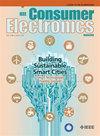Hierarchical Meta-Heuristic Encoder-Decoder Architecture With Next-Generation Imaging for Consumer-Centric Segmentation of Diabetic Foot Ulcers
IF 4.3
2区 计算机科学
Q1 ENGINEERING, ELECTRICAL & ELECTRONIC
引用次数: 0
Abstract
Diabetic foot ulcers represent a pressing global health concern, demanding precise and efficient segmentation for timely intervention and improved patient outcomes. This work proposed an approach named Hierarchical Meta-Heuristic Encoder-Decoder Architecture (HM-EDA) integrated with Next-Generating Imaging (NGI) for consumer-centric segmentation of Diabetic Foot Ulcers (DFUs). The proposed model is designed to address the challenges posed by the intricate nature of foot ulcer characteristics, leveraging the strengths of both hierarchical feature extraction and evolutionary optimization within the DenseNet architecture. HM-EDA is structured in a hierarchical manner, allowing for the extraction of multi-scale features from the input data. Additionally, an evolutionary optimization mechanism is embedded within the DenseNet framework to adaptively fine-tune model parameters, enhancing the overall performance and generalization capabilities. The internal architecture of the model is built up by using the cascading of the plain and reduced cell blocks with skip connections. We validate the proposed HM-EDA-NGI model using an extensive dataset comprising varied DFU cases, demonstrating its superior segmentation accuracy of 97.25%, Dice score as 0.95, and IoU as 0.94, compared to existing methodologies.分层元启发式编码器-解码器架构与下一代成像为消费者为中心的分割糖尿病足溃疡
糖尿病足溃疡是一个紧迫的全球卫生问题,需要精确和有效的分类,以便及时干预和改善患者的预后。这项工作提出了一种名为分层元启发式编码器-解码器架构(hmm - eda)与下一代成像(NGI)相结合的方法,用于以消费者为中心的糖尿病足溃疡(DFUs)分割。该模型旨在解决足溃疡特征的复杂性所带来的挑战,利用DenseNet架构中的分层特征提取和进化优化的优势。HM-EDA以分层方式构建,允许从输入数据中提取多尺度特征。此外,在DenseNet框架中嵌入了一种进化优化机制,以自适应微调模型参数,提高整体性能和泛化能力。模型的内部结构是通过使用跳跃连接的普通和简化单元块的级联来构建的。我们使用包含各种DFU案例的广泛数据集验证了所提出的HM-EDA-NGI模型,与现有方法相比,其分割准确率为97.25%,Dice得分为0.95,IoU为0.94。
本文章由计算机程序翻译,如有差异,请以英文原文为准。
求助全文
约1分钟内获得全文
求助全文
来源期刊
CiteScore
7.70
自引率
9.30%
发文量
59
审稿时长
3.3 months
期刊介绍:
The main focus for the IEEE Transactions on Consumer Electronics is the engineering and research aspects of the theory, design, construction, manufacture or end use of mass market electronics, systems, software and services for consumers.

 求助内容:
求助内容: 应助结果提醒方式:
应助结果提醒方式:


